National Grid on How Big is the Bridge
Transitioning to a Decarbonized U.S. Energy Infrastructure

The following article is taken from the “How Big is the Bridge” chapter of Dean Seavers’ Democratization of Energy eBook.
A future without carbon emissions – one that would have seemed impossible just a few decades ago – is now visible on the horizon. In this future, climate change has been slowed to a standstill and we’ve succeeded in preserving the planet for future generations. And our global society no longer needs to release carbon into the atmosphere to generate all of the affordable, reliable energy we need.
At the start of this eBook, I told you that I believe in this future. National Grid employees live, work, and play in the communities we serve. What better way to protect our communities than to take the lead in creating decarbonized energy networks that keep them healthy while also delivering smart, sustainable economic development?
Looking out to 2050, many frame the future in terms of renewable resources. When will all of our energy needs be met by wind and solar? These renewables will be vital to creating a sustainable economy, but it’s more useful to examine what we actually want that future to look like – a world with significantly decreased carbon emissions.
All three of the states National Grid serves, Massachusetts, New York and Rhode Island, have established 2050 goals of 80 percent reductions in emissions versus 1990 levels. These states have already made significant progress toward these targets. Since 1990, the amount of electricity generated from coal has fallen by 82 percent in New York and 66 percent in New England, leading to declines in carbon emissions of 52 percent and 35 percent, respectively.
So where is this new electricity coming from? While renewable energy sources grew, they still make up less than five percent of the electricity generation in the region. The real game changer was natural gas, which went from less than a quarter of the power generation in the 1990s to about half today.
There’s still a long way to go. Almost all of the emissions reductions in the Northeast to date have come from cleaning up power generation. Meanwhile, the region’s largest polluter, transportation – emissions from the tailpipes of trucks, trains, planes and all of our cars – hasn’t budged since 1990.
Our next step toward creating a decarbonized energy network should be to broaden our reach, using the same model that cleaned up power generation – a balanced approach of renewables, energy efficiency, and natural gas – to enable an all-electric transportation sector.
At the same time, we will continue to decrease heating emissions for homes and businesses by converting from oil to natural gas, just as the Veterans Affairs Medical Center in Northport, N.Y. did. The Northport VA’s conversion prevents 5,000 tons of carbon from escaping into the atmosphere every year, the equivalent of taking 3,500 cars off the road. And the medical center’s $2.5 million in savings can be invested back into programs that directly benefit veterans.
We’ve teamed up with the White House, Google and the Environmental Defense Fund, state regulators, and others on efforts to reduce methane emissions and make natural gas and even cleaner transition fuel. National Grid is also part of One Future, a seven-member coalition with the goal of achieving a methane leak rate of no more than one percent across the natural gas supply chain. You can imagine how natural gas forms a bridge that helps take us to a decarbonized future. It serves as a backstop to bring on more intermittent renewable energy generation until large-scale energy storage technologies become available. And we’re already coming up with new and fascinating ways to make that bridge even cleaner. Take Newtown Creek, where National Grid teamed up with the largest water treatment facility in New York City to produce renewable biogas from the waste stream and inject it directly into the local gas network. By converting a potentially harmful byproduct into a valuable source of cleaner heat, we’re scoring an economic and environmental victory.
While aggressive, our strategy sets the table for eliminating significant emissions from the energy supply chain without triggering economic disruption in local communities. Frankly, we can’t wait.
About the Author
Dean Seavers joined National Grid in December 2014 as President of National Grid in the U.S.
Dean’s long career has included leadership roles at GE, United Technologies, and Tyco. He led GE Security, a $2 billion product and technology group, and he also led a $4 billion global services portfolio for United Technologies.
At Red Hawk Fire & Security, Dean’s most recent venture, he was a founder and served as President and CEO. Red Hawk quickly became the second largest independent fire and security platform in the U.S., providing integrated security solutions to large and mid-sized commercial customers.
Dean has a strong background in financial strategy, performance improvement, and operational leadership. At National Grid, his focus is on continuing the performance progress that underpins the company’s U.S. business while driving its Connect21 agenda of building the advanced natural gas and electricity networks that are the foundation of our 21st century digital economy.
A native of Sandusky, Ohio, Dean graduated summa cum laude with a bachelor’s degree in business from Kent State University and earned an MBA from Stanford University’s Graduate School of Business.
Dean and his family have a home in Boston.
For more information please visit our website: www.nationalgridus.com, or our Connecting website. You can also follow us on Twitter, watch us on YouTube, Friend us on Facebook and find our photos on Instagram.

